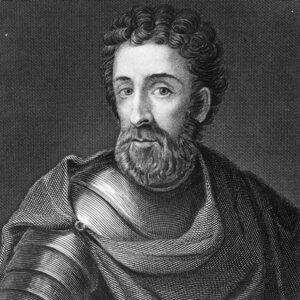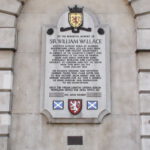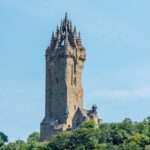Sir William Wallace
The Freedom Fighter of Scotland

William Wallace…
The Man and the Legend about which little is known was a scottish Freedom Fighter of the late 13th Century. The first and at the same time most controversial written presentation comes from Blind Harry’s Work ‘The Actes to Deidis often the Illustre and Vallyeant Campioun Sir William Wallace’, which was written around 1477. On some points, it contradicts the well-known historical Evidence, but Harry claims to have referred to a now lost source from Wallace’s environment. Even the benedictine Monk and Wallace’s Confessor John Blair is said to have already written a Biography of Wallace during his Lifetime.
Place and Date of Birth of William Wallace (gael: Uilliam Uallas), are not clearly documented. It is believed that he was born between 1270 and 1280, however, in a History from the 16th Century, the year 1276 is given as the Year of Birth. The Location is generally Elderslie near Johnstone in Renfrewshire, where Ellerslie in Ayrshire would be possible. As Parents, the Daughter of Sir Reginald Crawford, Sheriff of Ayr and Sir Malcolm Wallace, Laird of Ellerslie and Auchinbothie are suspected. However, in a Letter written by Wallace to the Hanseatic Cities of Lübeck and Hamburg after the Battle of Stirling Bridge, he is described as the Son of Alan Wallace (Filius Alani Walais). By a Seal find also the Knight David Wallace from the retinue James Stewart as a Father in question.
Childhood and Youth
The Wallace Family lacked the necessary Contacts to rise through military or social Successes. Therefore, Wallace should pursue the Career of a Clergyman and spent part of his youth with his Uncle, a Clergyman from the Cambuskenneth Abbey at Stirling, where he probably learned to read and write. Considering his Knowledge in military Tactics and Warfare, it can be surmised that Wallace decided against the Church and served as a Soldier in the Army of the scottish King (presumably Alexander III.).
Resistance to England
Even before his campaign of conquest in 1296 Eduard I. tried to gain power over Scotland.
There are said, that english Knights who was led by Sir Fenwicks dragged across the Country and killed his Father on the ‘Louden Hill’. This Event marked a turning point in the Life of Wallace and he came back from then on again and again with Englishman. During a visit to Dundee he was provoked by english Soldiers until the Swords were drawn. Wallace wounded the Sonn of the Constable of the City and he had to flee from angry Englishmen in the Woods.
After the Conquest by Edward I, the Scots were harassed and had to pay high Taxes.
According to Blind Harry, Wallace is said to have killed Fenwick, his Father’s alleged Murderer, during an english Raid on the Spot where his Father died. In May 1297, he killed William Heselrig, the Sheriff of Lanark, which earned him the Reputation of being a Rebel and public Enemy. The Reason is said to have been Marion Braidfoot, who was to marry the Son of Heselrig. Allegedly, Wallace married her and had a Daughter with her, whereupon Heselrig plotted to get rid of him. Historians assume that Heselrig had Marion killed and issued the Order to execute all those who sheltered an Outlaw, to execute their Servants and burn down their Homes.
Wallace is said to have waited some time and attacked the English with his Men, including his Friend Sir John de Graeme. Full of Hate he should have dismembered Heselrig into small Pieces and then left the Buildings light. The scottish Nobility became aware of his actions and Wallace received Support from some Families (albeit short-term). His most important ally was Andrew Murray, the Son of a Nobleman from northwestern Scotland. Another Nobleman who joined Wallace was Sir William Douglas of Douglasdale, who, however, pursued more of his own Destinations.
In early July 1297, about 50,000 english Soldiers crossed the scottish Border and met with their Opponents at Ayr, but no Battle was fought. Instead, a dispute arose over the succession of the Scottish parties, with Wallace and Murray speaking out for John Balliol. As a Result, Wallace and Murray left the Army and fought alone, without the Support of the Nobility. After several Battles and Sieges Wallace finally led the Scots successfully in the ‘Battle of Stirling Bridge’.
Despite the arrogance of the Nobility, Wallace began social Advancement and he was first named ‘Guardian of Scotland’, later even knighted. From this time comes a letter that Wallace wrote to the Hanseatic Cities of Lübeck and Hamburg and is kept in the Archives of Lübeck. In this letter he assures the two Cities of free Circulation with all scottish Ports.
Diplomatic Travel
A year later, his Fame and Influence ended with his defeat at the Battle of Falkirk. Shortly thereafter, Wallace gave up his post as Guardian and apparently left Scotland to win as a Diplomat Allies for the reinstatement of Balliol and an independent Scotland. As targets Blind Harry calls in his work Norway, Paris and Rome, which -as the “Adventures” which he experienced in the Travel and more like Stories from a Novel- are not occupied.
Wallace is said to have carried a Letter from the norwegian King Haakon, who granted him safe Conduct and was taken from him in a Capture. Since he saw the Cities of Lübeck and Hamburg as Allies, they would also be possible as Destinations for his Travels. In Paris and Rome he appeared to be heard by the King and Pope, for both wrote to the english King that he should withdraw his troops from Scotland.
Execution
In 1302 Wallace returned to Scotland and continued his Fight against England, but lost more and more Support. February 1304, the scottish Army surrendered and Eduard pardoned most, with one Exception … William Wallace.
In July 1305 Wallace traveled to Glasgow and hid in the Area of Robroyston, but was betrayed, the exact Circumstances are not clear. One Theory is that Wallace was betrayed by the Servant Jack Short. Another says that he was betrayed by the Scotsman Ralph de Haliburton, who wanted to obtain his Detention.
It is certain that Wallace was captured by a Group of english Knights, led by Sir John Menteith, in August 1305. Allegedly, he was surprised Sleep and spent with a two-week trip- tied to a Horse to London, where a Court in the ‘Westminster Hall’ should judge him. The List of Indictments was long, including Atrocities against members of the Church and the Sheriff of Lanark. Also showing his Banner was listed, which would have been allowed only to the Monarch to show that it was a legitimate War.
Wallace had to remain silent during the Trial. However, when Sir Peter Mallore brought charges of High Treason, Wallace contradicted unsuccessfully. He was sentenced to Death by hanging, eviscerating and quartering, and this was already determined from the beginning.
Wallace was tied to a horse naked and drifted through the Streets for several Hours as the Residents threw Stones at him. He was then almost hanged to Death, spayed alive, gutted, and his Innards burned before his Eyes.
According to a Legend, he is said to have called his Tormentors under Torture that as a Scot he does not recognize Eduard as King. The following words are handed down:
You english Dogs you, effeminate Whores are you, kisses my scottish Butt and are proud to be able to do this, something better can not happen to a miserable Englishman!
Wallace finally succumbed to his Agony and his Body was dismembered.
As a Warning, his Arms and Legs were sent to Newcastle, Berwick-upon-Tweed, Stirling and Perth. His Head was impaled on the London Bridge.

A Plaque on the ‘St. Bartholomew’s Hospital in London-Smithfield remind to the Place of his Execution. To commemorate Wallace, in 1869 was built the Wallace Monument at Sterling -a 67 meter-high Tower. In it is also the Sword, that he is said to have killed 50 mounted Soldiers.

The Events around Wallace in his Fight against England were filmed in 1995 in ‘Braveheart’.
In March 2013, the BBC released the Documentary William Wallace – The True Braveheart.
(Unfortunately, I found the documentation only in German)